Seven steps to co-designing a patient engagement plan
By: Andrea Pike and Krystal Bursey (in consultation with the larger author team for Operationalizing a patient engagement plan for health research: Sharing a codesigned planning template from a national clinical trial)
In 2019, the De-implementing Wisely Research Group (made up of researchers, clinicians and patients in NL, ON, and AB) launched a CIHR SPOR-funded research study aiming to reduce imaging for low back pain and routine preoperative testing for low-risk surgeries. The group is committed to meaningful patient engagement. To that end, patients are a part of our steering committee, formed their own Patient Partnership Council, and are considered full partners in our work. The patients on our team recognized early on that we needed a plan for engaging patients in project activities and were instrumental in the push for a robust and detailed patient engagement plan.
Getting Started
While we agreed on its importance, how to go about developing that plan was a bit of a mystery for everyone. We began by reviewing existing models of engagement such as the International Association for Public Participation (IAP2) which identifies five levels of engagement ranging from lesser to greater levels of engagement: inform, consult, involve, collaborate and empower.¹
Conceptually, as you move up the levels, greater levels of decision-making power are available to patient partners. This model has been modified for research purposes and is a widely accepted standard for describing patient engagement in research projects.²
The Problem
However, none of the patient engagement models we were aware of, including the IAP2, defined what it means to engage with patients at these different levels for the many different activities that occur in a project lifecycle. They also didn’t answer some of our most practical questions like “what does it mean to engage with patients at an involve level for choosing study measures or developing a knowledge translation product versus engaging at the collaboration level?” or “Who decides what parts of the project need patient engagement?” or “Do all patients need to engage at the same level for each activity?” With little concrete guidance available in the literature, the research team (which includes our patient partners) embarked on a journey to develop our own process of co-developing a patient engagement plan.
We describe our approach and each step of the process in detail here: https://onlinelibrary.wiley.com/doi/full/10.1111/hex.13417
Briefly, we began by selecting an engagement framework which shaped our overall approach to patient engagement, and clarified its goals and the scope of patients’ involvement in the research project. Next, the research team reviewed the major project activities and decide where patient input was most needed. Once those were selected, careful thought was needed about what level of engagement could be offered, for each project activity. At this stage, we selected as many levels of engagement as possible to ensure opportunities for deeper levels of engagement were not lost.
The next step, describing the levels of patient engagement for each activity, was perhaps the most important, tangible step in the creation of our patient engagement plan. It allowed researchers, staff members, and patient partners to fully understand what would be required from all parties to participate at each level of engagement. In fact, it’s so important we created a downloadable template to accompany our publication. Describing the levels of engagement in this way was critical for the research team to complete the next step — deciding which levels of engagement, for each activity, was realistic given project resources, timelines, number of patient partners, etc. Once that was decided, it was important to seek feedback from patients. In our case, the patients on our research team were able to fill this role. If you are developing a plan but don’t yet have patient partners engaged, you could work with a separate patient council to ensure that the patient and researcher roles and responsibilities are easily understood and defined. Finally, it was time to survey our patient partners so they could choose how they wanted to be involved in the project activities that were outlined.
Overall, this process is labor intensive — especially operationalizing the levels of engagement. The result, however, is a process and a planning template that we believe is highly transferable to any health research project. We believe it has the potential to make the process easier for others, produce more robust patient engagement plans, and ultimately lead to deeper levels of patient engagement in health research.
[1] International Association for Public Participation IAP2 spectrum of public participation; 2018. https://cdn.ymaws.com/www.iap2.org/resource/resmgr/pillars/Spectrum_8.5x11_Print.pdf. Accessed May 12, 2021.
[2] Bammer G. Key issues in co-creation with stakeholders when research problems are complex. Evid Policy. 2019; 15(3): 423- 435.
Subscribe to our monthly newsletter at http://bit.ly/SupportLettersSubscribe.
